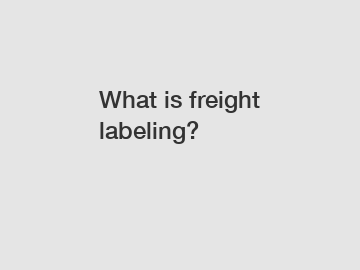Jan. 03, 2024
Packaging & Printing
What is freight labeling? Let's delve into this essential process of categorizing and identifying shipments for smooth transportation. Understanding freight labeling is crucial for businesses involved in logistics and supply chain management. In this article, we will explore the fundamentals of freight labeling, its significance, best practices, and the benefits it offers. So, let's get started!
1. What is freight labeling?
Freight labeling is the process of attaching labels or tags to shipments to provide important information for efficient handling, storage, and delivery. These labels typically include details like the shipper's and consignee's addresses, tracking numbers, barcodes, and other relevant data necessary during transportation.

2. The significance of freight labeling.
Accurate labeling is paramount in ensuring smooth and efficient movement of goods through the supply chain. It allows carriers, warehouse personnel, and delivery drivers to swiftly locate, sort, and handle shipments. Freight labeling also plays a crucial role in minimizing errors, enhancing visibility, and reducing the risk of loss or damage to goods during transit.
3. Best practices for freight labeling.
a. Standardization: Adhering to industry-standard labeling conventions helps promote uniformity and consistency across different parties involved in the shipping process. This ensures that everyone can easily understand and interpret the information on the labels.
b. Clear and legible information: Labels should be printed clearly and neatly, ensuring all the necessary details are legible. This helps avoid confusion or misinterpretation of information and prevents unnecessary delays or errors.
c. Use of barcodes: Incorporating barcode technology on freight labels enables automated scanning and tracking, significantly improving accuracy and efficiency. Barcodes facilitate real-time updates, ensuring smooth communication between various stakeholders.
d. Proper placement: Labels should be affixed prominently on the shipment in a location that is easily visible and accessible. This facilitates easy identification and reduces the time required for manual handling and sorting.
e. Quality materials: Labels should be made of durable materials capable of withstanding various environmental factors, such as temperature fluctuations, moisture, or rough handling. This ensures the labels remain intact throughout the entire shipping process.
4. The benefits of effective freight labeling.
a. Improved visibility: Accurate labeling helps provide real-time visibility of the shipment's location and status. This allows shippers, carriers, and customers to track the progress of their goods, enhancing transparency and reducing the risk of lost or misplaced shipments.
b. Enhanced efficiency: Proper labeling streamlines the entire logistics process, enabling faster sorting and handling of shipments. This leads to improved productivity, reduced handling time, and faster delivery times, which is especially crucial in time-sensitive supply chains.
c. Minimized errors and delays: Precise labeling with accurate information minimizes errors, such as wrong deliveries or misrouted shipments. This helps prevent unnecessary delays, reduces costs associated with error rectification, and enhances overall customer satisfaction.
d. Regulatory compliance: Certain industries, such as food, pharmaceuticals, or hazardous materials, have specific labeling requirements to comply with safety regulations. Proper freight labeling ensures compliance, avoiding legal issues or penalties.
e. Increased customer satisfaction: Efficient labeling enables timely and accurate deliveries, which ultimately results in satisfied customers. A seamless shipping experience, with properly labeled packages, enhances trust and strengthens customer relationships.
In conclusion, freight labeling is a crucial aspect of the logistics and supply chain management process. Implementing best practices for accurate and efficient labeling brings numerous benefits, including enhanced visibility, improved efficiency, minimized errors, regulatory compliance, and increased customer satisfaction. By understanding the significance of freight labeling and adopting proper labeling practices, businesses can optimize their shipping operations and drive growth in today's competitive marketplace. So, make sure to prioritize effective freight labeling for smooth and successful transportation of goods.
If you are looking for more details, kindly visit embossed hardcover book, custom embossed book cover, hardcover book printing with embossing.
If you are interested in sending in a Guest Blogger Submission,welcome to write for us!
All Comments ( 0 )